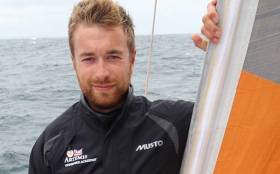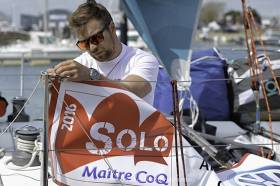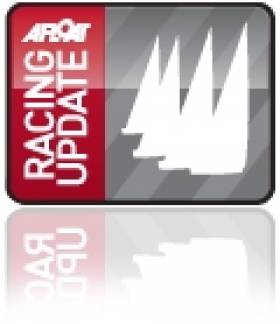Displaying items by tag: Hammy Baker
Strangford Lough's Andrew 'Hammy' Baker Appointed RYA Northern Ireland High Performance Manager
Accomplished sailor Andrew Baker has been appointed as the new RYA Northern Ireland Performance Manager, taking up the post this week.
Recruitment for the role started in February but was delayed until lockdown measures eased and continued funding form Sport Northern Ireland was confirmed.
Baker takes over from Ballyholme-based 49er sailor Matt McGovern who previously held the role.
Popularly known as 'Hammy' Andrew started competitive sailing at the age of nine, racing Toppers in his native Northern Ireland. By the age of 13, he was selected to be part of the RYA Northern Ireland Youth Squad in Toppers, and two years later in the Laser Youth Squad. After winning the Northern Ireland Youth National Championship, he represented Ireland in the Laser Europeans and World Championship. In 2014, Andrew was selected as part of the British Keelboat Academy and won the IRC National Championship.
His big break came when he got accepted into the Artemis Offshore Academy to be part of the 2015 squad. After training in Lorient, he took part in his first Solitaire – Bompard Le Figaro, finishing the race in 32nd place. Since then he has worked as a professional sailor but has also returned to work and assist as a Senior Instructor at his home club of Quoile YC in Strangford Lough.
Welcoming Andrew to the RYA Northern Ireland team, Chief Operating Officer Richard Honeyford said: "At RYA Northern Ireland, we are delighted to welcome Andrew on board as the new Performance Manager at a critical time for performance sport and our local athletes. With the Olympics delayed until 2021, Andrew will be looking to ensure our High-Performance athletes get the best possible support as well as looking to ensure the pathway and club development plans are prioritised."
Commenting on his new post, Andrew said: "Since our first family holidays on my parents' boat right up to sailing competitively at a professional level, I have always felt very fortunate to be involved in this sport and I realise it would not be possible if not for the work of our clubs, volunteers and the work carried out by the RYANI. Having gone from club racing and through the squad systems myself I know how important this stage of coaching and nurturing is to a future athlete. I hope to carry on the great work carried out by my predecessors and give something back to the sport I love through growing the depth of sailing here in Northern Ireland. To me sailing is a sport for life and I hope it can be for others too."
Strangford Lough solo sailor Andrew ‘Hammy’ Baker has been announced as the newest team member of Enda O'Coineen's campaign to be the first Irish person to compete in the Vendee Globe race, the non stop, unassisted, race around the world, the Everest of sailing challenges.
Hammy is part of the team that will prepare the boat, optimise performance, and work with Skipper O’Coineen ahead of the Vendee Globe Race start in November.
Hammy aspires to be the first Northern Irish sailor to compete in the Vendee Globe. The race takes place every four years and involves a grueling lap of the planet, alone, through the Southern Ocean. Speaking about the announcement Hammy said:
“To be involved in an all Ireland Team is definitely a huge step towards that end goal… This week he sailed into Belfast where he spent his life sailing on O'Coineen's IMOCA 60.
He previously competed in a solo sailing campaign in a 33-foot yacht where many of the top ocean racers learn the ropes.
The boat will be in Dublin on a round Ireland promotional voyage this weekend.
Strangford Lough's Hammy Baker Eyes Strong Performance in Second Race of 2016 Figaro Calendar
Strangford Lough sailor Hammy Baker is among a line up of British sailors from the Cowes-based Artemis Offshore Academy are looking to post strong results in the week-long Solo Maitre Coq race that starts from Les Sables d’Olonne today.
With several of the main Figaro competitors currently racing across the Atlantic in the Transat AG2R La Mondiale race, this year’s Solo Maitre Coq – the second of the main build-up races to the Solitaire Bompard Le Figaro in June – offers an opportunity for strong performances from both Artemis Offshore Academy alumni and rookies.
The Maitre Coq starts with two days of inshore racing off Les Sables d’Olonne. After a rest day on Wednesday, there is then a long 280-mile offshore race that could see the sailors at sea for up to three days. The key to a good result is consistency across both disciplines and stamina over what promises to be a tough week of racing in the 33ft Bénéteau Figaro II one-design fleet.
As well as Northern Ireland's Baker there are five British sailors on the 22-boat startline, three alumni sailors – Alan Roberts (Vasco de Gama), Nick Cherry (Redshift) and Hammy Baker (Artemis 64) – and three rookies in Will Harris (Artemis 77), Mary Rook (Artemis 37) and Hugh Brayshaw (Artemis 23).
With strong dinghy racing backgrounds, both Roberts and Cherry will be looking for a good start to the championship and will hope to be well up in the standings after the four inshore races. Baker, who is returning to racing alone after competing in the double-handed division of the Solo Concarneau Trophée Guy Cotten, is hoping to match them.
“My goal is to be in the top-half of the fleet and definitely top-10,” said the Ulsterman, “but then again I have only managed to get two days of training in since the Concarneau race, so I’ll have to see when I get out there…it’s a bit like riding a bike, when you have been off it for while you can still be a bit rusty.”
Among the British rookies Will Harris will be looking to continue the sparkling form he showed in the Solo Concarneau when he started brilliantly and then sailed confidently to finish top-rookie and sixth overall in a 23-boat fleet. Harris is hoping he can bring the same level of performance to the Maitre Coq.
“There is only one guy racing here who was ahead of me in the Concarneau race,” said Harris, aged 22 from Surrey. “In terms of achievement I wouldn’t put a result on it but I want to come away from the week feeling I have given it my all. It’s going to be a very different experience, especially because we have inshore racing this time. If you have a bad start, you haven’t got three days to catch-up. Every race counts and you can’t have a bad result in any of them.”
Charles Darbyshire, director of the Artemis Offshore Academy, is in Les Sables d’Olonne to keep eye on his charges and says the Solo Maitre Coq is another big step on the road to the Figaro for the rookies. “This will give the sailors a flavour of what it is like in the Solitaire in terms of rest and recovery time between races,” he said. “On Monday and Tuesday they will be off the dock at 9.00am and will not be back until seven after a long day on the water. Then they only have Wednesday to recover and plan for the long offshore race which will be two nights at sea.”
The weather forecast for Les Sables d’Olonne promises two light wind races today and then breezier conditions for tomorrow’s inshore contest. The long offshore race was looking like a thrash in 30-knots, but latest predictions suggest a wind range of 10-15 knots, giving a total passage time for the 280-mile course of up to three days.
Kiwi Makes Top Start at Laser Worlds
The strong tidal current and light and at times very shifty breeze proved to be the principal challenges on the first day of the Laser World Championships off Hayling Island. It left Irish Olympic campaigner James Espey in 52nd, the top third of the senior fleet. Ronan Cull is in 152nd and Paul McMahon is 157th in the 159 boat fleet.
For those sailors who had spent the preceding days, or – for some – weeks, learning venue's nuances idiosyncrasies it was intelligence gained about the tidal current which was of immediate value.
Racing Day 1 broke the pattern of blustery winds and intermittent rain which have prevailed through pre-championships training phase, replaced absolutely on cue by bluebird skies, summer sunshine and light to moderate mainly northerly breezes.
New Zealand's Michael Bullot, runner up at last year's World Championships in Halifax, Nova Scotia made the strongest start across the two testing opening races by posting a second and a first in the first of four days of scheduled Qualifying heats.
His early statement of intent saw the Aucklander ashore this afternoon with a lead of one point over Skandia Team GBR's Paul Goodison, the Olympic and defending World Champion who opened his regatta with third place and then won his second heat by a comfortable distance.
The shifting directions of the wind, oscillating through as much as 30 degrees at times in the Standard fleet's first race set the early test, but a big 50 degrees swing early in of the second contest, kept the racers and the race team on their toes; the second and third starts were delayed until the breeze settled.
According to Goodison patience was his key virtue through both races, waiting until changes in the breeze were sufficiently established enough to make a consideredmove, rather than falling to the temptation to try and benefit every small change.
And with up to a knot of current running and the direction of flow progressively changing, flowing to the NW at the start of Race 1 and moving to the NE tactical decisions were a movable feast, rich with opportunities to make gains and losses.
Australia's double world champion Tom Slingsby, who arrived late Saturday at Hayling Island fresh from winning the Etchells World Championships with America's Cup legend John Bertrand, showed no sign of ring rustiness when he won his first heat, but he admitted to trying to breaking from the pack's conventional thinking on the first downwind of the second race, and his error dropped him four boats to score an eighth.
Among those finishing their first day with results which were well ahead of their expectations were Nicholas Heiner who won the first heat for the Yellow fleet, the biggest senior triumph yet for the young Dutch sailor who seeks to emulate or better the record of his 1996 Finn Olympic bronze medallist father, whilst Estonia's Karl-Martin Rammo paired up a third and first to match the first day 4pts tally of Goodison.
In the Junior World Championships Italy's Francesco Marrai leads the 118 boat fleet after posting a second and third. Competing for Ireland are Chris Penney, Aidan McLaverty and Hammy Baker.
Laser World Championships, Hayling Island GBR,
After Day 1
1 Michael Bullot (NZL) 1,2, 3pts
2 Paul Goodison (GBR) 3,1 4 pts
2 Karl-Martin Rammo (EST) 3,1 4pts
4 Luka Radelic (CRO) 2,2 4pts,
5 N Thompson (GBR) 2,3 5pts,
6 Pavlos Kontides (CYP) 4,3 7pts
7 Tom Slingsby (AUS) 1,8 9pts
8 Matthias Del Solar (CHI) 4,5 9pts
9 Andrew Murdoch (NZL) 6,4 10pts
10 Giacomo Bottolli (ITA) 9,4 13pts
Junior World Championships
1 Francesco Marrai (ITA) 2,3 5pts
2 Lukas Feuerherdt (GER) 1, 5 6pts
3 Thorbjoern Schierup (DEN) 3,3 6pts
4 Bogoslav Bugarin (CRO) 8,5, 13pts
5 Antony Munos (FRA) 14,2 16pts
Paul Goodison (GBR): "The first race started off in a really shifty breeze, up to 12 knots but it dropped back to five or six knots with some big swings in the wind. I think it was a bit of a patience game waiting for the wind to come back. It can be too easy to go chasing things, but the wind usually came back and so that was a bit of a patience game.
The second race got super light just before the start but at the gun there was probably 10-11 knots, that dropped to about 4-5 knots, but there was nearly a knot of tide and so it was very important to stay inside the laylines with that much of tide running. Quite a lot of the fleet got outside the port tack layline which meant them reaching in and pushing tide and that hurt them quite a lot.".
" We had three great weeks of breeze at Sail for Gold and for the two weeks since, and so here today it has been nice to remember how to do it in the light winds."
"After Sail for Gold I did three days here and then arrived her last week and have been sailing most days since then."
Andrew Maloney (NZL): "It was pretty shifty. I got a good start at the pin and then got a nice left shift and so managed to cross the fleet and from there it was just about sailing on the lifted tack and staying in the pressure on the downwind legs. It sounds easy but it wasn't!
The start and the first beat were vital and when you were out in front it got easier.
I was second at the first mark. He got back into the second left shift half way up the beat and that made the difference."
Nick Heiner (NED): "I had a really good start at the pin end, five boats from the pin and got a nice shift to the left and from there on was always ahead of the fleet, and could play with the shifts. Downwind I was not that fast, but I managed to stay ahead. But now I know what to work on for the coming days. It was a good start.
I like it here, with the current and the waves it is good fun, a bit like home in Schevenigen where I have trained a lot."
Tom Slingsby, (AUS): " I always say you can't win the regatta on the first day but you can lose and I managed not to do that which is good. It was a very tricky day with a lot of current. I got through pretty well, not as well as some but I am pretty happy with my day.
I have to say I was feeling a bit rusty on the way out to the start. Everyone else was kind of cruising around and I was racing trying to get used to it, trying to get the feel back. But all in all I sailed fine.
The first race was light, six to ten knots, I sailed quite well and rounded second and slowly caught the leader to win. The second race I was about fourth or fifth. But with the downwind the current was washing us straight across the course, I decided to take a bit of a risk and not join the train as we call it, and I broke away and unfortunately it did not work, but it could have been worse."
Karl-Martin Rammo (EST): "It was the best day of my life so far, off the charts. I managed to get in the front of the fleet early. First race I had a mediocre start but got to the front of the fleet by just sailing the shifts, I was kind of the middle but just got it right. It was so shifty and gusty.
The second race I had a really good start at the pin and tacked immediately and went pretty much to the right corner and was ahead at the upwind mark, had a mediocre downwind mark but has a good second upwind."
Nick Thompson (GBR): "All in all it was a pretty good start In the first race it was very shifty, probably averaging 10-12 knots at times but with big changes in pressure but it was nice to race in with lots of opportunities to come back. The second race was tough with strong current running which really skewed the course too much, but the race committee did a good job in moving the windward mark to square it up and so it was a decent race."
































































